小学四年级下册外研版英语第四册教案
(完整版)外研版四年级英语下册教案(全套)
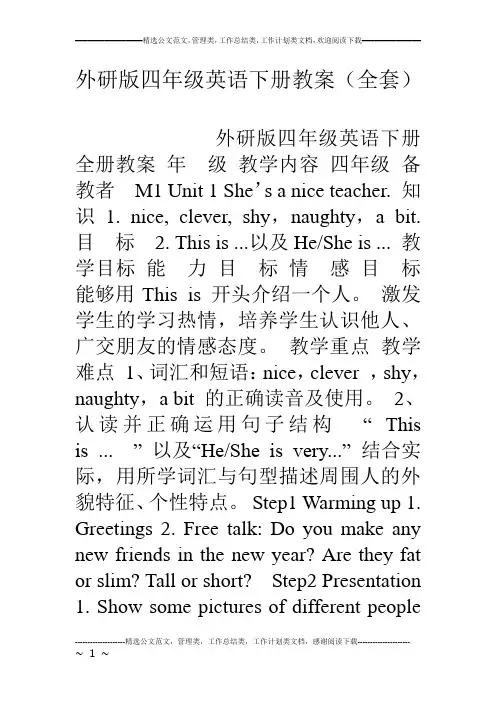
外研版四年级英语下册教案(全套)外研版四年级英语下册全册教案年级教学内容四年级备教者M1 Unit 1 She’s a nice teacher. 知识 1. nice, clever, shy,naughty,a bit.目标 2. This is ...以及He/She is ... 教学目标能力目标情感目标能够用This is 开头介绍一个人。
激发学生的学习热情,培养学生认识他人、广交朋友的情感态度。
教学重点教学难点1、词汇和短语:nice,clever ,shy,naughty,a bit 的正确读音及使用。
2、认读并正确运用句子结构“ This is ... ” 以及“He/She is very...” 结合实际,用所学词汇与句型描述周围人的外貌特征、个性特点。
Step1 Warming up 1. Greetings 2. Free talk: Do you make any new friends in the new year? Are they fat or slim? Tall or short? Step2 Presentation 1. Show some pictures of different peopleto the students. 2. Ask students to say out their remarkable features. 3. Then the teacher writes the adjective words on the board. 4. Talk T: The man is 200kg. So he is... S: He is fat. T: Who is fat in your class? S: ... T: Who is tall in your class? S: ... Step3 New Teaching 1. Students listen to the tape and answer the follow questions: a. Who is nice but a bit shy? b. Who is a nice teacher? c. Who is a clever pupil?e. Who is naughty but not a bad bird? 2. Find out new words and sentences, and then write them on the board 3. Learn the new words and sentences.备注话题接近生活,学生有较大的发挥空间,较浓的兴趣。
外研社(三起)四年级英语第四册:Module 4 Robots Unit 1 Robots will
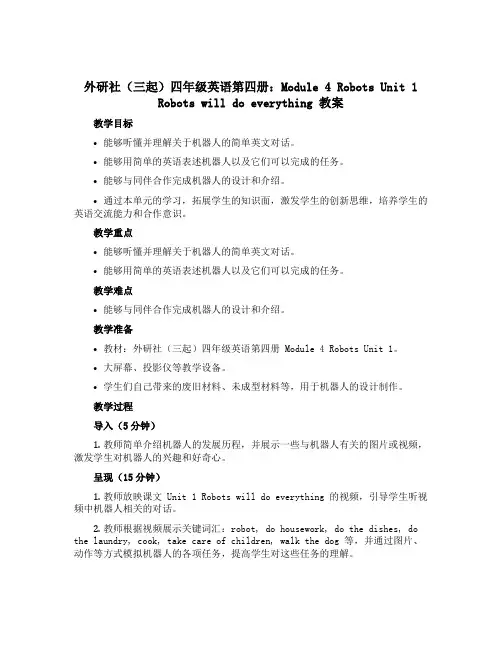
外研社(三起)四年级英语第四册:Module 4 Robots Unit 1 Robots will do everything 教案教学目标•能够听懂并理解关于机器人的简单英文对话。
•能够用简单的英语表述机器人以及它们可以完成的任务。
•能够与同伴合作完成机器人的设计和介绍。
•通过本单元的学习,拓展学生的知识面,激发学生的创新思维,培养学生的英语交流能力和合作意识。
教学重点•能够听懂并理解关于机器人的简单英文对话。
•能够用简单的英语表述机器人以及它们可以完成的任务。
教学难点•能够与同伴合作完成机器人的设计和介绍。
教学准备•教材:外研社(三起)四年级英语第四册 Module 4 Robots Unit 1。
•大屏幕、投影仪等教学设备。
•学生们自己带来的废旧材料、未成型材料等,用于机器人的设计制作。
教学过程导入(5分钟)1.教师简单介绍机器人的发展历程,并展示一些与机器人有关的图片或视频,激发学生对机器人的兴趣和好奇心。
呈现(15分钟)1.教师放映课文 Unit 1 Robots will do everything 的视频,引导学生听视频中机器人相关的对话。
2.教师根据视频展示关键词汇:robot, do housework, do the dishes, do the laundry, cook, take care of children, walk the dog 等,并通过图片、动作等方式模拟机器人的各项任务,提高学生对这些任务的理解。
合作探究(20分钟)1.教师告知学生,他们需要分为若干小组,每组设计一个未来的机器人,并为机器人取一个英文名称。
2.学生们自己带来废旧材料等,根据小组的设计图纸开始机器人的设计和制作。
3.在制作过程中,教师为学生们提供必要的指导,督促学生们积极参与制作,呈现他们的天马行空的创意。
4.设计完成后,每个小组需要介绍他们的机器人的名称、功能、外形等英文特点。
学生可以通过图片、口语交流等方式进行展示。
外研英语四年级下优质教案:Module4 Unit 1 Will you take your kite(1)
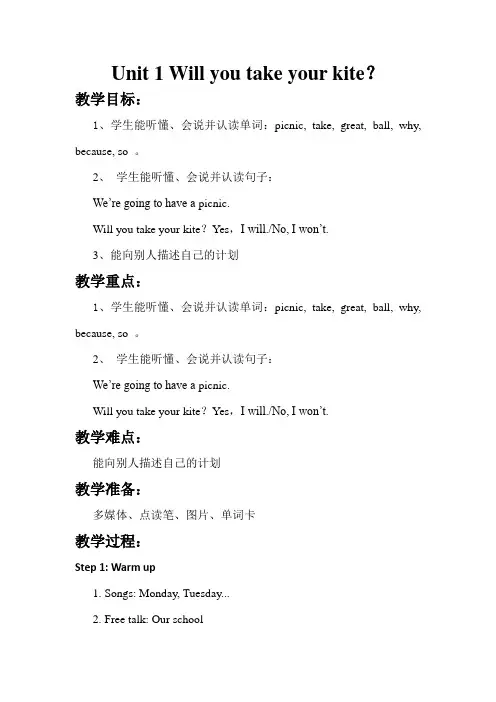
Unit 1 Will you take your kite?教学目标:1、学生能听懂、会说并认读单词:picnic, take, great, ball, why, because, so 。
2、学生能听懂、会说并认读句子:We’re going to have a picnic.Will you take your kite?Yes,I will./No, I won’t.3、能向别人描述自己的计划教学重点:1、学生能听懂、会说并认读单词:picnic, take, great, ball, why, because, so 。
2、学生能听懂、会说并认读句子:We’re going to have a picnic.Will you take your kite?Yes,I will./No, I won’t.教学难点:能向别人描述自己的计划教学准备:多媒体、点读笔、图片、单词卡教学过程:Step 1: Warm up1. Songs: Monday, Tuesday...2. Free talk: Our schoolStep 2: Presentation1. Listen and point.T: It’s a ball. (Show the ball) I’m going to play ball. Will you play with me?S2: Yes, I will.T: I’m going to go to Hainan. Will you take a ball? (同时板书)S2: No, I won’t.2. Teacher shows the cards about the new words. Students follow the teacher .The students read one by one.S1: Will you go to park tomorrow?S2: Yes, I will.S3: Tomorrow you’re going to have a Music lesson.S4: No, I won’t.Step 3: Teacher-student interaction1. Two students play a game .They choose one food or one object and do the action.S1: Will you take some noodles?S2: No, I won’t.S1: Will you take a cake?S2: Yes, I will.2. Four students look some pictures and tale about.S1: We’re going to go to Hainan tomorrow. I will take my coat andmy hat. Will you take your swimsuit?S2: No, I won’t. I’ll take my coat, too. Will you take your gloves?S3: Yes, I Will.S4: I will take my swimsuit.评出最佳一组给予奖励。
新版外研版四年级英语下册module4教案.doc
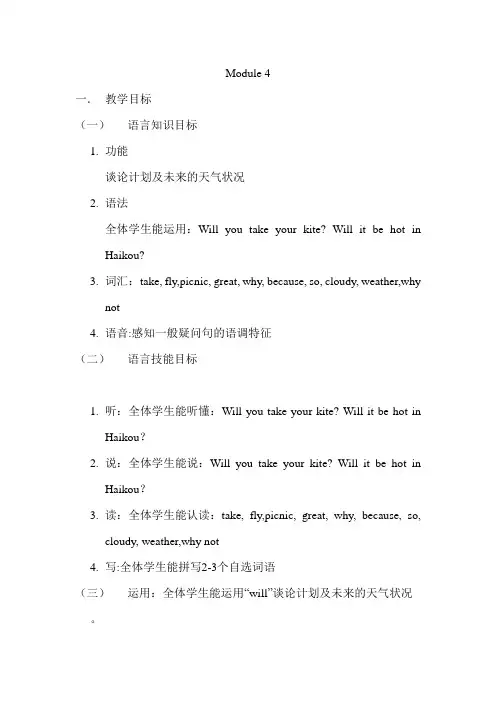
Module 4一.教学目标(一)语言知识目标1.功能谈论计划及未来的天气状况2.语法全体学生能运用:Will you take your kite? Will it be hot in Haikou?3.词汇:take, fly,picnic, great, why, because, so, cloudy, weather,whynot4.语音:感知一般疑问句的语调特征(二)语言技能目标1.听:全体学生能听懂:Will you take your kite? Will it be hot inHaikou?2.说:全体学生能说:Will you take your kite? Will it be hot inHaikou?3.读:全体学生能认读:take, fly,picnic, great, why, because, so,cloudy, weather,why not4.写:全体学生能拼写2-3个自选词语(三)运用:全体学生能运用“will”谈论计划及未来的天气状况。
(四)学习策略:在课堂交流中,注意倾听,积极思考(五)文化意识:了解我国各地的气候差异(六)情感态度:积极参与各种课堂学习活动二.教材分析1.本模块的教学内容是谈论未来的计划及天气状况。
2.Unit1的课文情景是爸爸告诉Amy和Sam星期六要去野餐。
3.Unit2的课文情景是机器人接听小朋友询问全国各地天气状况的电话。
4.重点学习“will”的一般疑问句结构,培养学生运用“will”一般疑问句的能力。
5.掌握关于天气的名词及符号。
三.本单元教学内容(一)重点学习“will”的一般疑问句结构,培养学生运用“will ”一般疑问句的能力(二)掌握重点单词take, fly,picnic, great, why, because, so, cloudy, weather,whynot(三)掌握重点句子(四)Will you take your kite? Will it be hot in Haikou?四、本单元教学重难点1.掌握“will”的一般疑问句结构2.掌握并能灵活运用重点单词: take, fly,picnic, great, why, because,so, cloudy, weather,why not等5.3.掌握重点句子:Will you take your kite? Will it be hot inHaikou?五、本单元在全册的地位分析联系了上一模块的知识,并重点学习了“will”的一般疑问句的结果,是学生系统地接触了一般将来时态,启着巩固的作用。
外研版第四册英语全册教案
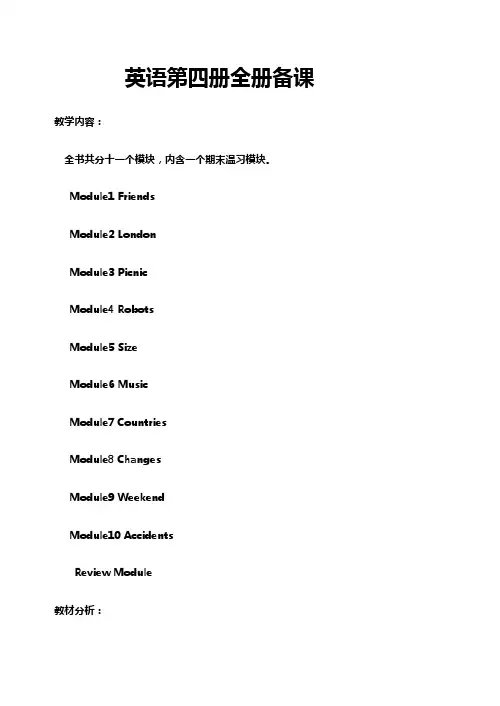
英语第四册全册备课教学内容:全书共分十一个模块,内含一个期末温习模块。
Module1 FriendsModule2 LondonModule3 PicnicModule4 RobotsModule5 SizeModule6 MusicModule7 CountriesModule8 ChangesModule9 WeekendModule10 AccidentsReview Module教材分析:本册教材是供小学四年级下学期利用的。
全书共分11个模块,内含一个期末温习模块。
每一个模块分为两个单元。
一样情形下,第一单元呈现本模块所要学习的语言内容,第二单元提供假设干任务型练习,包括一首歌或小诗。
歌谣或小诗的学习,目的有三:一是培育学生的语感和节拍感;二是提多发音的正确性;三是通过这些英语国家儿童所熟知的歌谣,介绍必然的西方文化。
其中的一些不经常使用的单词,不要求学生在歌谣之外学会利用。
在本册中,咱们将学习礼拜的表达方式,谈论有关郊游的情形,初步了解有关伦敦和美国的基础知识;咱们将进一步学习如何表达能力,如何谈论以后发生的情形;咱们还将学习如何描述过去的动作与状态,专门是如安在讲故事的深造讲述过去的动作与状态。
教学目的:一、培育学生的语感和节拍感。
二、提多发音的正确性。
三、通过这些英语国家儿童所熟知的歌谣,介绍必然的西方文化。
教具预备:录音机、课件等教学方法:一、确信适当的教学目标。
二、制造良好的学习气氛。
三、在课堂上尽可能利用英语,适当利用汉语。
四、鼓舞、帮忙学生,适当纠正错误。
五、利用多媒体教学。
教学进度表:第一模块单元分析本模块分两单元Unit 1 She's a nice teacher.anUnit 2 He's cool. 整个模块介绍了如何描述人物的性格特点?要求学生能够用简单的句子对老友的性格、外形进行描述。
同时温习了上学期学过的一些单词fat thin small big tall short ,从而引出naughty shy nice clever等几个新单词。
外研版英语四年级第四模块集体备课
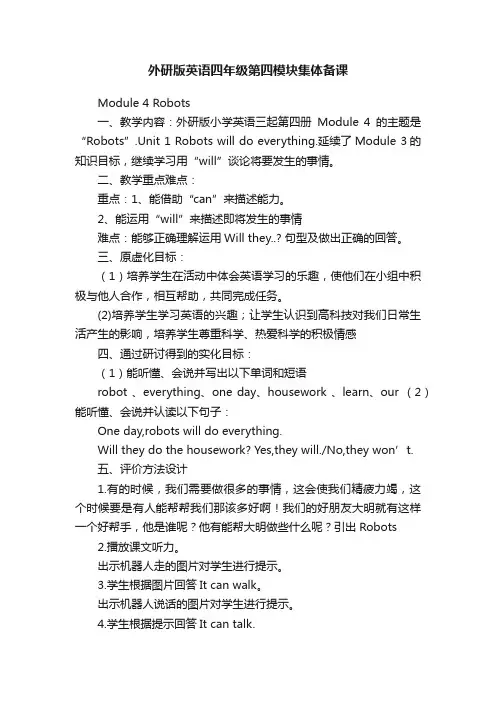
外研版英语四年级第四模块集体备课Module 4 Robots一、教学内容:外研版小学英语三起第四册Module 4的主题是“Robots”.Unit 1 Robots will do everything.延续了Module 3的知识目标,继续学习用“will”谈论将要发生的事情。
二、教学重点难点:重点:1、能借助“can”来描述能力。
2、能运用“will”来描述即将发生的事情难点:能够正确理解运用Will they..? 句型及做出正确的回答。
三、原虚化目标:(1)培养学生在活动中体会英语学习的乐趣,使他们在小组中积极与他人合作,相互帮助,共同完成任务。
(2)培养学生学习英语的兴趣;让学生认识到高科技对我们日常生活产生的影响,培养学生尊重科学、热爱科学的积极情感四、通过研讨得到的实化目标:(1)能听懂、会说并写出以下单词和短语robot 、everything、one day、housework 、learn、our (2)能听懂、会说并认读以下句子:One day,robots will do everything.Will they do the housework? Yes,they will./No,they won’t.五、评价方法设计1.有的时候,我们需要做很多的事情,这会使我们精疲力竭,这个时候要是有人能帮帮我们那该多好啊!我们的好朋友大明就有这样一个好帮手,他是谁呢?他有能帮大明做些什么呢?引出Robots2.播放课文听力。
出示机器人走的图片对学生进行提示。
3.学生根据图片回答It can walk。
出示机器人说话的图片对学生进行提示。
4.学生根据提示回答It can talk.出示课文图片提示学生回答It will do the housework.出示课文图片提示学生回答It will help children learn.学生分组讨论还希望机器人能够做的5. 学生分组讨论还希望机器人能够做的事,然后教师总结:The robot can’t do these things now,but one day they will do everything.。
外研版四年级下册英语教案- Module4 unit1 Will you take your kit
外研版四年级下册英语教案- Module4 unit1 Will you takeyour kite?一、教学目标1.学生能够听说读写单词和短语:kite, take, happy, park, go, fly a kite, have a picnic2.学生能够能够运用本单元所学单词和短语进行交际并复述并描述人们的活动。
3.学生能够理解并能够使用“Will you + 动词原形”这一简单的句式。
二、教学重点1.学生在听、说、读、写以及口语表达方面的能力提高。
2.通过学习和活动,激发学生的学习兴趣和情感体验。
三、教学难点1.学生能够运用本单元所学单词和短语进行交际并复述并描述人们的活动。
2.学生理解并能够使用“Will you + 动词原形”这一简单的句式。
四、教学准备1.外研版四年级英语教材、课件、教具、活动道具、小黑板。
五、教学步骤1. Warm-up教师与学生做简单的英语相互问候。
然后,教师播放一段风筝飞行的视频,并带领学生进行简单的口语交流。
Example questions: 1. Have you ever flown a kite? 2. What kind ofkite do you like? 3. Where is a good place to fly a kite? 4. What will you do if your kite is stuck in a tree?2. Presentation教师现场拿一只风筝,向学生展示,询问他们风筝怎么飞,然后教师拿出一本书,并点读并解释“We will have a great time flying kites.”这句话的意思,然后教师呈现单词happy, kite和take,并点读和板书。
3. Practice教师出示一份活动安排表,让学生们看,然后询问他们在学校或学校周边活动时通常做些什么。
教师然后让学生找一个同桌或一个朋友,并询问他们是否会一起放风筝。
外研版英语(三起点)四年级下册全册教案(教学设计)
外研版英语四年级下册全册教案学校:____________教师:____________2020年3月Module 1Unit 1 She’s a nice teacher.知识目标:a) 能听、说、认读下列单词:nice、clever、shy、naughtyb) 能听懂、会说下列句型:He’s / She’s a bit/ very …c) 初步了解转折的表达方式:She’s very nice. But she’s a bit sh y. 能力目标: 能简单描述周围人的性格特征、个性特点。
情感目标:能用英语向他人介绍某人的性格特征、个性特点,培养学生认真观察、善于观察的好习惯,进一步通过活动使学生热爱英语,培养学生团结友爱、互帮互助的良好习惯。
教学重点:描述性格的形容词汇与句型的学习和运用。
教学难点:描述周围人的性格特征、个性特点。
教具:学图片、单词卡片、单词陀螺、课件。
每人一张人物个性特点调查表。
教学过程Ⅰ热身复习. (3’)①问候:T——S②听唱歌曲《The more we get together.》(学生一边拍手一边唱)Ⅱ呈现新授(20’)通过歌曲引出本课的话题T:This is a song about friends. Today we will talk about our friends. let’ssee who can describe his\her friends best. And let’s see which group is the best in this class.T: Now the first, let’s recognize Panpan’s fr iends. 课件出示Panpan’s的四位朋友Do you want to know how does Pan-pan appraise his friends?播放录音,让学生们回答下列问题(1)What are their friends names?(2)What is each person’s temperament?让学生尽可能用英语回答问题.(1)课件出示毛毛的图片T: Who is she? (Maomao)What’s she like? (nice \a bit shy)S: She’s nice.T: Yes. And she’s nice. But a bit shy(课件出示单词、教读、拼读单词)nice. a bit shy(板贴图片、板书单词)S: Practise in groups.(因为以前曾经接触过,所以由学生来当小老师进行检查)T: Who is nice in our class?(学生通过观察,根据实际情况回答问题,对单词和句子有更深刻的理解)(2)教师用同的方法出示小勇的图片新授单词clever(3)教师用同的方法出示鹦鹉的图片新授单词naughtyⅢ课文学习(5’)1、教师播放录音,学生边听边用手指出相应的图片。
Module4(教案)外研版(三起)英语四年级下册
教案:外研版(三起)英语四年级下册 Module 4一、教学目标1. 知识目标(1)能够听懂、会说、会读本模块的重点单词和句型。
(2)能够运用所学知识进行简单的日常交流。
(3)了解本模块的主题内容,提高学生的英语学习兴趣。
2. 能力目标(1)培养学生的听力理解能力。
(2)培养学生的口语表达能力。
(3)培养学生的阅读能力。
3. 情感目标(1)激发学生学习英语的兴趣。
(2)培养学生的团队协作精神。
二、教学内容2. 句型:How are you? I'm fine, thank you. And you? Yes, please. No, thank you. That's all right.3. 对话:教材P3334。
三、教学重点与难点1. 重点:本模块的单词、句型和对话。
2. 难点:单词的准确发音和日常对话的运用。
四、教具与学具准备1. 教具:教材、录音机、磁带、课件。
2. 学具:课本、练习本、铅笔、橡皮。
五、教学过程1. 热身(5分钟)(1)学生自由交谈,询问彼此近况。
(2)教师引导学生用英语进行问候,如Hello, Good morning等。
2. 课堂导入(10分钟)(1)教师播放课件,展示本模块的主题内容。
(2)引导学生用英语进行日常问候,如How are you?等。
3. 新课呈现(10分钟)(1)教师出示单词卡片,引导学生学习单词。
(2)学生跟读单词,教师纠正发音。
(3)教师呈现句型,引导学生进行口语练习。
4. 课堂实践(10分钟)(1)学生分角色朗读对话。
(2)学生模拟对话,进行实际操作。
5. 巩固练习(10分钟)(1)教师设计练习题,让学生进行听力练习。
(2)学生完成练习题,教师批改并讲解。
(2)学生分享学习收获。
7. 课后作业(布置作业)(1)学生抄写单词。
(2)学生完成课后练习题。
六、板书设计Module 4句型:How are you? I'm fine, thank you. And you? Yes, please. No, thank you. That's all right.七、作业设计1. 抄写Module 4的单词。
外研版英语三起四年级下册四模块教案
外研版英语三起四年级下册四模块教案Module 4。
Unit 1。
Teaching Aims:1. Enable the students to understand and use the key words and phrases, such as "zoo," "panda," "elephant," "tiger," "monkey," "lion," "giraffe," and "kangaroo."2. Enable the students to understand and use the sentences "What can you see?" "I can see a panda," "What can it do?" "It can climb trees," "What can you do?" "I can jump," and "Can you see a tiger?" "Yes, I can/No, I can't."3. Enable the students to understand and use the dialogue "What can you see?" "I can see a panda." "What can it do?" "It can climb trees." "What can you do?" "I can jump." "Can you see a tiger?" "Yes, I can/No, I can't."4. Enable the students to understand and use the song "What Can You See at the Zoo?"Teaching Key Points and Difficulties:1. Key vocabulary: zoo, panda, elephant, tiger, monkey, lion, giraffe, kangaroo.2. Key sentences: "What can you see?" "I can see a panda," "What can it do?" "It can climb trees," "What can you do?" "I can jump," and "Can you see a tiger?" "Yes, Ican/No, I can't."3. Key structure: "What can you see?" "I can see a panda."Teaching Procedures:Step 1: Warm-up。
- 1、下载文档前请自行甄别文档内容的完整性,平台不提供额外的编辑、内容补充、找答案等附加服务。
- 2、"仅部分预览"的文档,不可在线预览部分如存在完整性等问题,可反馈申请退款(可完整预览的文档不适用该条件!)。
- 3、如文档侵犯您的权益,请联系客服反馈,我们会尽快为您处理(人工客服工作时间:9:00-18:30)。
Module 1Unit 1 S he’s a nice teacher.Teaching objectives:1. Words and phrases: nice \ a bit \ shy \ clever \ naughty2. Sentences: This is Ms Smart.She is a nice teacher.3. Grammar: Using adjectives to describe person. Teaching properties: cards \ pictures \ photo \ Tape-recorder\ CAITeaching procedures:A: Song: There are twelve months in the year.B: Free talk: Talk about your holiday.C: New concepts:Step one:One :利用CAI课件, 出示本单元主人公的头像,介绍主人公,以此引出本单元新单词:nice \ a bit \ shy \ clever \ naughty 出示卡片,学习新单词。
Two: Learn the new lesson.Listen to the tape .Try to read the text. Translate thesentences.Listen to the tape again, read follow the tape.Read the text, boys and girls.Step Two: Talk about the pictures.Close your books, show the pictures (parrot,Xiaoyong,Maomao,Ms Smart) Example :( 1) This is Parrot.Parrot is a very naughty bird.(2) This is Xiaoyong .He’s a clever pupil.Step Three: Using adjectives to describe person.利用实物投影展示学生带来的照片。
(Describethe person using the adjectives Homework: Introduce your classmates to your family.Example: This is Xiaoyong.He’s a clever pupil.Game: 接龙游戏Example: A: I’m XiaoLan. I’m a bit shy.B: XiaoLan is a bit shy. I’m ZhangYong. I’m very nayghty.C: ZhangYong is very naughty. I’m Jim, I’m a nice boy.…Designs: Module One: Friends1Module 1Unit 2 H e’s cool.Teaching objectives:1. Words and phrases: cool \ little \ cute.2. Sentences: This is this is my big brother, He’s cool.T eaching properties: cards \ Tape-recorder \ CAI Teaching procedures:A: Song: Row Row Row your boat.B: Free talk: Using adjectives to describe the poem.C: New concepts:Step one: Warmer:Using the adjectives to describe your classmates.Example: ① This is Xiaoyong.He is a clever pupil.② This is Yuanjiaqi.She’s very clever, but she’s a bit shy.Step Two: Listen and point.(1) Point out the different meanings of the word―cool‖.In this unit, ―cool‖ means fashionab le, and it is most commonly used to mean ―quite cold‖. The word ―cool‖ has other meanings as well, but they are ones that the students are unlikely to come across in the future.(2) Listen to the tape and underline the new words.Write down these adjectives on the board, and then learn these new words.Listen to the tape again. Read the text.Close your book. Use CAI shows the pictures of text.Choose some students to describe the pictures.Step Three: Listen and say, then say the poem and do the actions.Play the spoken version of the poem. And have thestudents. Repeat each line. Play the tapeand have the students.Step four:Tell the students that they are going to work in groups of three or four.Do the AB unit 2.Homework:Choose some words to write about your friend. Example: This is my friend×××. She is a clever pupil. At school, she’s a bit shy, but at home, she is very naughty girl. Game:Explain that they are going to play a game where they have to whisper some information to their classmate. That classmate has to whisper the information to the next person. The last person. That person has to say that he \she heard. Then, the other students listen carefully to find out if the2message has changed at all.Designs:Unit 2 He’s cool.mother --- nicebig brother --- coollittle sister --- cutefather --- cleverfriend --- naughtyModule 2Unit 1 London is a big city. Teaching objectives:1、Words and phrases:capital, about, beautiful,be from2、Sentences:I’m from London.London is the capital of England.It’s very big and very beautiful.3、Grammar: the present tenseTeaching properties: cards, pictures, tape—recorderTeaching procedures:Step 一、导入利用卡片教授“capital”,反复领读,读熟之后带入句子“London is the capital of England.”中。
Then translate it into Chinese. 找生用英语说出“北京是中国的首都。
”鼓励学生踊跃参加抢答赛“说首都”,学生可以用中文说。
Step 二、新授在愉快的氛围中,师告诉学生:“Amy 和Lingling 是同班同学。
一天,Amy 带来了一本关于自己家乡—伦敦的书。
Lingling 看见这本书后非常好奇,于是就请Amy 向她介绍伦敦的情况。
现在我们就来跟Amy 学一学怎样描述城市和景物。
今天学习过后,请大家也来介绍一下自己熟悉的城市、地区或景物。
请学生听录音,听一听Amy 和Lingling 之间的对话。
师:“Where is London?”生在地图上指出伦敦的位置。
再放一遍录音,让学生在自己的书上勾出描述城市的形容词(nice, big, beautiful, small)。
请学生根据插图和上下文猜一猜每个生词的意思。
“beautiful”一词教师要反复示范,借助肢体语言帮助学生读清并理解这一单词。
个别单词处理完之后,教师领读课文几遍。
然后鼓励学生分角色大胆试读,教师及时给予表扬。
Step 三、练习完成SB 第一单元活动3。
把全班分成两人一组,3分别扮演Amy 和Lingling,进行问答练习。
例如:1、A: What’s this? B: I t’s a book about London. It’s very nice.2、A: What’s the capital of England? B: It’s London.Step 四、作业完成活动用书练习1到练习4。
Designs:Module 2Unit 2 It’s very old.Teaching objectives:1、Words and phrases:long, wide, many, river, old, famous2、Sentences:This is the River Thames.It’s long and wide.3、Grammar: Using adjectives to describe cities and buildings.Teaching properties: cards (pictures), tape—recorder, CAI Teaching procedures:A: Song: Chant: This is a little girl.B: Talk about: Using adjectives to describe a person’s personality and London.C:New concepts:Step 一、Warmer:Revise adjectives. Tell the students that I am going to say an adjective. They have to find something in their books that the adjective describes. Ask two or three students to say which object the chose.Example:T: It’s big. S1: (points to London) London.S2: (points to elephant) Elephant. S3: (points to Beijing) Beijing.4Do more examples with the class.Step 二、Listen, point and say:1、Listen, point and find out the new words and underlime them. Then revise them using cards or pictures. (Write down these words on the board.)2、After doing this, tell the students to close their books.I am going to say the first word of a two-word place name. These places are all in London. The students have to say the second word of the two-word name.Example:T: Buckingham…Ss: …Palace.T: Hyde…Ss:…Park.3、Have the students continue the activity in pairs. They should take turn to say the first word.4、Showing four pictures on the screen about "the River Thames", "Big Ben", "Hyde Park", and "Tower Bridge". (Write down these words.) The same time, I am going to read the text for the students. Have them remember the sentences. The second times, ask some students to introduce the pictures.5、Games: Guessing game.6、Do AB Unit 2 exercise 1. Quiz: Listen and say the answers.7、Showing AB Unit2 exercise 2 on the screen. Do thisexercise together.Step 三、Practice1、Do SB Unit2 activity 4. Listen and point. First, have students say something about these pictures. Then listen and guess which one is right.2、Do AB Unit2 exercise 4. Write about your school building.Step 四、Learn to sing1、Have the students look at the picture and describe it (children playing a game).2、Tell the students that this song, 'London Bridge is falling down' is a traditional English song. Explain that London Bridge is a very famous bridge in London.3、Play the spoken version of the song and have the students repeat each line. Play the tape and have the students sing the song.4、Explain the actions and have the class sing the song again. Choose some students to come to the front and play it. Let's see "Who is the winner?"Have the students sing and do the actions after class. Step 五、HomeworkMake a survey to compare London and My hometown. You can using "This is …It's (very)…" and the other sentences to introduce.5London My HometownCountryLanguageBig/Small…Games:1、Guessing gameTell the students that I am going to say adjectives and they have to think of some places in China that these adjectives describe.ExampleT: Old. S1: Great Wall. S2: Palace Museum. Designs:Module 3Unit 1 Robots will do everything.Function: Describing things in the future and talking about abilitiesTeaching points:1.Sentences: One day, robots will do everything.2. Words and phrases: robot everything one dayhousework learn our that3. Using will to describe things in the futureTeaching properties: cards tape-recorder CAITeaching procedures:(1) Warming up: ---Greeting.---Listen and act : e.g. wash clothes watch TV run walk play the flute play football jump do homework make a cake row a boat play table tennis (运用肢体语言来复习动词及动词词组,为本课will 的学习做好铺垫)(2) Presentation: Show a robot to the class and say ―Today we’re going to talk about the r obots.‖Describing the robots, it can sing. It can dance. One day, robots will do everything. (运用图片展示robot的含义) Ask t o the students ―What else will the robots do?‖ Show the CAI to students. (让学生看课件了解机器人能做什么不能做什么)6Now show the text to the students. Look at the book and ask. What can Daming’s robot do? Will robots do the housework? Will robots help children learn?...Write the answers on the board: It can walk.Then drill this sentence and then change the word ―walk‖.Talk about the sentences: They will do the housework. They will help children learn.Write the sentence on the board One day, robots will do everything. (用磁卡带替换动词及动词词组,让学生运用所学。
